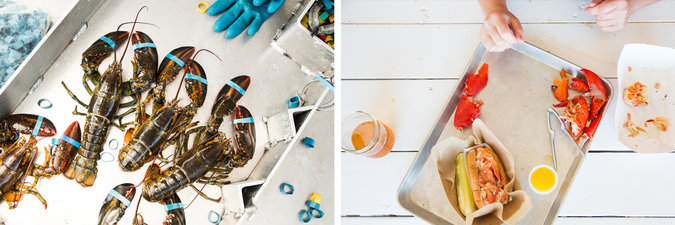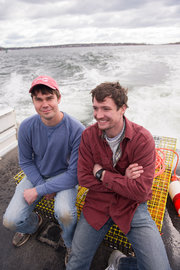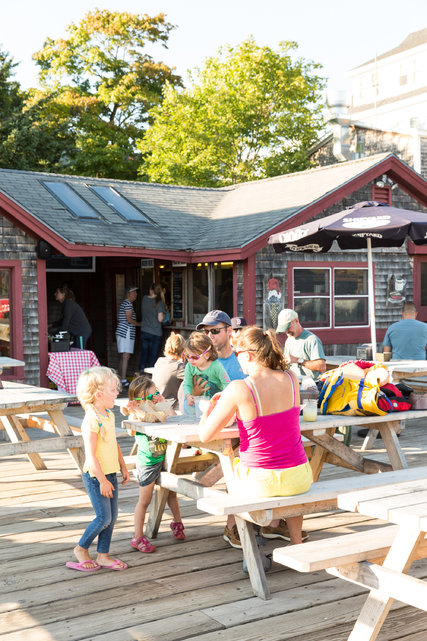He holds an ownership stake in a co-op of Maine fishermen, which allows him to track where and how the lobsters are caught, and control the quality, freshness and pricing. He also owns the processing plant, Cape Seafood, that packages and prepares the lobsters for his restaurants.
Advertisement
Continue reading the main story
“We’re able to trace every pound of seafood we serve back to the harbor where it was sustainably caught and to support fishermen we know and trust,” Mr. Holden said. “There’s no middleman in that whole chain.”
This might seem obsessive. But in business, it’s called a vertical integration strategy.
Consumer demand for fresher, healthier ingredients has led to a surge in the popularity of farmers’ markets and local food co-ops over the last five years, said Bonnie Riggs, a restaurant analyst at the NPD Group, a market information and advisory firm.
For restaurants, though, simply buying fresh, all-natural ingredients isn’t enough, as food-safety concerns like E. coli scares continue to plague the industry.

Oil companies have long practiced a vertical integration strategy to track and control the flow of petroleum from the oil field to the gas pump, said Jennifer Friedman, vice president of Wolters Kluwer’s BizFilings, a legal services company that helps businesses incorporate. Now the practice is gaining momentum in the food industry.
“Owning one or more levels of the supply chain is a highly effective way to maintain quality and obtain an advantage against competitors,” Ms. Friedman said.
For Mr. Holden, who had zero experience in the restaurant industry, it has been a steep learning curve.
Mr. Holden, now 32, was raised in Cape Elizabeth, a town of fewer than 10,000 people just outside Portland. His father, Jeff, worked as a fisherman and lobster processor, and his mother, Donna Lu, as a schoolteacher.
He spent summers working on the docks, helping his father at a lobster processing plant at the age of 10. He unloaded fish on the wharves at 13 and worked as a sternman at 16. At 17, he built his own 16-foot boat in woodworking class in high school, and dropped his own lobster traps in Tenants Harbor up the Maine coast.
Advertisement
Continue reading the main story
His parents wanted more for him and encouraged him to go to Georgetown University. He graduated with a bachelor’s degree in business administration in 2007 and took a job as an investment banker in New York.
Ultimately, though, investment banking “wasn’t where my passion was,” he said. With $34,000 in his pocket in August 2009, he set out to build Luke’s Lobster. “My mother’s reaction was to cry,” he said.
His father’s relationships with the Maine lobster industry helped him buy directly from the fishermen. He posted an ad on Craigslist, where he found his business partner, Ben Conniff.
Mr. Conniff, 31, was a Yale graduate who had been writing for magazines and blogs in New York when he met Mr. Holden. Though he had little experience in the food industry, he jumped at the chance to help start a business.

On Sept. 1, they signed a lease in the East Village, hammered a sign on the door — “Luke’s Lobster coming soon” — then hustled to get building permits, health inspection approvals, furniture and a staff in time for the Oct. 1 opening.
Mr. Conniff used his storytelling skills to promote the business to food bloggers and on social media.
“We had such great buzz that we sold 500 lobster rolls on the first day and did nearly $10,000 in business,” said Mr. Holden, who recalled customers lining up around the block. Within 17 days, they had broken even and were making plans for their next restaurant opening.
Luke’s Lobster generated sales of $20.9 million in 2015, up from $327,408 in its first year in 2009. Mr. Holden is projecting sales of $25 million this year and $42 million in 2018.
Plans are in the works to open six new restaurants this year and 40 more by 2020. The company now has 125 full-time employees and 175 part-time workers, while Cape Seafood employs another 125 full-time people.
Advertisement
Continue reading the main story
Still, there were some hiccups. In the beginning, it was just the two of them doing everything. “My responsibilities ranged from permitting and hires to cleaning toilets and making food,” Mr. Conniff said.
Navigating New York’s bureaucratic quagmire to obtain building and health inspection permits was — and continues to be — a challenge. Mr. Conniff recalled spending many hours being shuffled from floor to floor with paperwork before hiring an expediter to get the permits.
Although they managed to get all the permits in 30 days for the first restaurant, it hasn’t been that fast since. “It now takes us six months to a year to do it — never just 30 days,” Mr. Holden said.
In the early days, they sometimes ran out of lobsters and buns; Mr. Holden’s father would have to make “midnight runs” from Maine to bring them in.

Luke’s success also hinges on persuading a casual-food diner to pay $17 for a lobster roll rather than buy a burger and fries.
“It’s easier to sell a burger at Shake Shack’s price point or a burrito at Chipotle’s price point than it is to sell a lobster at our price point,” Mr. Conniff said. “It’s our constant job to tell the story of why our seafood is better and help everyone understand why it costs what it costs.”
In 2012, the founders built their own processing plant, Cape Seafood in Saco, Me., outside Portland. This year, they took an ownership stake in a fisherman’s co-op in Tenants Harbor in Maine, completing the vertical integration strategy — from ocean to table.
Securing the co-op partnership took some finesse. It took more than a dozen meetings to persuade members to sign up, said Merritt Carey, a consultant and member of the co-op board.
Advertisement
Continue reading the main story
When Mr. Holden agreed to buy all of the co-op’s catches for his restaurants, support its sustainability practices and give the co-op 50 percent of the profits from a Luke’s Lobster restaurant that is attached to the wharf, the fishermen agreed.
One fisherman, John Tripp, 28, said he was so impressed with the partnership that he left the wharf in South Thomaston where he was working with his father to join the Tenants Harbor co-op.
The co-op produces 20 percent of the lobsters that Luke’s restaurants need. The rest come from sustainable harbors in other parts of Maine, as well as from New Brunswick and Nova Scotia in Canada.
Jay Takefman, a partner at Quilvest Private Equity, recently took an equity stake in Luke’s Lobster. He previously invested in restaurants like Baja Fresh, which was sold at its peak to Wendy’s for $275 million in 2002.
He doesn’t rule out a sale or initial public stock offering for Luke’s Lobster eventually.
“We didn’t put any time frame on this,” Mr. Takefman said. “We’re patient capital and long-term investors.”
Mr. Holden said he had not thought that far ahead.
“I love this business and it’s a part of who I am and who I want to be,” he said. “It’s something I want to continue to have a role in for the indefinite future.”
Continue reading the main story
Article source: http://www.nytimes.com/2016/08/25/business/smallbusiness/lukes-lobster-restaurants-coops-seafood.html?partner=rss&emc=rss
Speak Your Mind
You must be logged in to post a comment.